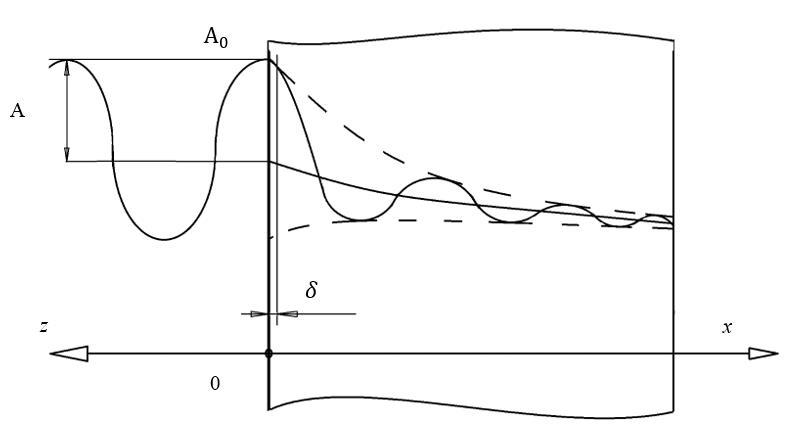
18 minute read
ROSTISLAV OLIYNYK: INSULATING WOOD WOOL PANELS USING LOW-GRADE PINE WOOD
ACTA FACULTATIS XYLOLOGIAE ZVOLEN, 64(1): 15−24, 2022 Zvolen, Technická univerzita vo Zvolene DOI: 10.17423/afx.2022.64.1.02
INSULATING WOOD WOOL PANELS USING LOW-GRADE PINE WOOD
Advertisement
Olena Pinchevska – Ján Sedliačik – Denys Zavialov – Yuri Lakyda –Olha Baranova – Hanna Lobchenko – Rostislav Oliynyk
ABSTRACT
The effective use of low-grade pine wood (Pinus Sylvestris L.) affected by rot, the volume of which is currently growing mainly due to climate change is proposed in the paper. Pine wood in the form of wood wool was proposed to use as an insulating filling inside the structure of wall panels. Modification of wood wool was carried out with various binders to ensure its biological stability. The experimentally verified calculation of thermal properties confirmed the proposed construction of wood panels with specified insulation, as well the wall thickness fulfils requirements according to building codes for construction engineering. The minimum thickness of the outer walls of frame wooden houses withstanding daily or seasonal temperature fluctuations was determined. Key words: pine wood, rot wood, biostability, wall panel, wood wool insulation, thermal resistance, thermal conductivity
INTRODUCTION
Demand for pine wood as a lightweight, fast-renewable construction material for building structures constantly increases. However, its active consumption and almost tenfold excess of felling compared to afforestation has led to a shortage of high quality raw materials (SHVETS et al. 2020). Given the change in natural and climatic conditions, the spread of pests affecting pine stands increases the amount of low-grade deadwood (DE MEO et al. 2017, PERSIANI et al. 2016, MANTAU 2012, MAURER and PINCHUK 2019). It encourages the search for additional reserves of wood suitable for the use in industry. The use of low marketable wood is limited, as its processing reduces the yield quantitatively and qualitatively. Nevertheless, this kind of wood is an additional and little-used resource that can become a raw material if involved into a processing of products with higher added value (DANILOV et al. 2018, BABASHOV et al. 2017, MARCHENKO et al. 2016).
The consequences of dieback of pine stands are partial loss of technical suitability of wood due to biological damage – rot, the causative agents of which are fungi such as Phellinus Pini, Mucor, Cladosporium, etc. (PERSIANI et al. 2016, ERIKSSON et al. 1990, AGARWAL et al. 2011). The analysis of the use of low quality wood shows that possibilities of its use as a wood component of composite wood materials and raw materials for pulp production are limited, because the quality requirements on wood chips allow the use of the wood with fungal lesions in relative quantities not exceeding 15-30 % (MANTAU 2012,
UGOLEV 2007, WITOMSKI et al. 2011). Currently, wood damaged by rot is used as an energy fuel source, although this use as a biofuel features low profitability.
The use of rot-damaged wood for structural elements in constructions is unacceptable (LEONOVICH and BOZHELKO 2019), however, it can be used in the manufacture of related materials for construction, e.g., as a thermal insulation material. Cement-chipboards –arbolite and fibrolite, which are made mainly of waste from woodworking industries or secondary raw materials, are now widely used in the building industry as the thermal insulation materials. Organic and mineral substances are used as binders (SANAEV et al. 2016, UGOLEV 2007). However, when manufacturing this type of boards, the use of wood with rot is not allowed.
The manufacture of wood wool from low quality wood affected by rot is proposed in accordance with timber treatment, especially in the presence of visible mycological effects (PINCHEVSKA and ZAVIALOV 2020a, PINCHEVSKA and ZAVIALOV 2020b). For the use of wood wool as insulation, panels are manufactured using material treated with various types of binders with antiseptic properties. Wood affected by heart rot and sapwood affected by coloration was used. Inorganic binders based on liquid glass and organo-mineral binders based on PVA dispersions with different ratios of binder and wood component were selected for the use. The test of such material treated with organo-mineral binders to counteract the fire did not ignite the material, the maximum flue gas temperature was about 120 °C, and the flammability index was 0. Studies on sound insulation properties have shown that this material can be attributed to sound insulation materials of class 2 (TSAPKO et al. 2019a).
In order to be able to use the proposed panels made of wood wool, their thermal conductivity was determined. It was 0.094 W/m·K for panels with inorganic binder, and 0.079 W/m·Kfor panels with organo-mineral binder (TSAPKO et al. 2019b). A comparison with the values of thermal conductivity of traditional thermal insulation materials, such as mineral wool 0.070 W/m·K, indicates the possibility of using wood wool for insulation. The use of wood wool panels is supported by the fact that, unlike mineral wool, they are nontoxic and can be used in wooden houses, given that the technology of their production can be classified as «green technology».
The aim of the study is to determine the wall panel thickness with the appropriate bioresistant thermal insulation using material made of low-grade pine wood, which will provide a comfortable atmosphere in rooms of wooden houses.
METHODS
The main task of enclosing structures is the insulation of influence of external factors on the microclimate in the rooms despite the daily temperature fluctuations. Thermal insulation of walls features the main role in equalizing the microclimate temperature, i.e., the insulation of changing external influences. These fluctuating temperature processes allow us to describe them as non-stationary heat transfer processes in the proposed wood panel with wood wool insulation – Figure1.
Fig. 1 Design of the proposed panel.
The process of heat transfer in the wall panel can be described by the Fourier equation, where the coefficient of thermal conductivity depends on the thermal conductivity and heat capacity of each layer:
��2������ ����2 (1)
( 0; 0 �� →∞) where: х – coordinate directed deep into the panel (m); ������ – panel temperature (°С); ������ – effective coefficient of thermal conductivity of the wall panel (m²/s):
(1+
2��2 ��1 )
2
∙��1∙��2
(��1+��2∙
2��2 ��1 )∙(��1��1+��2��2
2��2 ��1 ) (2)
where: �� – thermal conductivity of the layer material (W/m·K); �� – layer material thickness (m); �� – heat capacity of the material (J/kg·K).
To ensure the comfort of people in the room it is necessary to take into account the daily temperature fluctuations associated with changes in air temperature caused by periodic exposure to the sun. The heat propagation of solar radiation has a wave character which properties will have a damped nature of oscillations in a multilayer plate with heat-insulation (Figure 2).
Fig. 2 The process of damping thermal oscillations with an initial amplitude А0 in the panel.
The temperature fluctuations (°C) inside the panel can be described as follows:
��(��, ��) =А�� cos(����−��−√ �� 2������ ∙��) (3)
where: А�� – amplitude of temperature fluctuations inside the panel, which will be equal to:
А�� =А0 �� 2������ ∙��) (4)
where: А0 – initial value of the amplitude of oscillations that have maximum values on the surface and correspond to half of the oscillations of the surface temperature under the action of solar radiation; �� – time (s); �� – frequency of daily temperature fluctuations �� = =
2�� ��
2�� 86400 ≈7.3∙10−5 �� −1; P – daily period of fluctuations.
To substantiate the design characteristics of the panel, it is necessary to know its minimum thickness, at which the temperature fluctuations are completely attenuated. Given that, the thermal oscillating process in the panel is damped and the change in amplitude is exponential. The thickness of wall panel under the condition that the amplitude of the temperature decreases “ е ” times (е= 2.71828) can be calculated, then:
А0 А�� =�� ⟹√2 �� ������ ∙���� =1. (5)
Temperature fluctuations on the surface with a certain delay are transmitted deep into the panel and gradually attenuate because of the panel insulating properties. With the characteristics of the materials the wooden panel with insulation is made from (TSAPKO et al. 2019a) and using equation (2), it is possible to calculate at what panel thickness temperature fluctuations from the outside will be imperceptible on the inner surface of the panel.
According to the requirements of the standard (DSTU BV.2.6-189: 2013) when calculating the thickness of enclosing structures,heat transfer resistance R (m2·K/W) is used. It determines the resistance to heat transfer of external walls, RΣ, in accordance with building regulations (DBN B.2.6-31: 2016):
1 ��в +∑�� ��=1 ���� ������ 1 ��з (6)
where: αВ, αЗ – heat transfer coefficient of inner and outer surfaces of enclosing structure of a building (W/m2·K), in accordance with Annex B of the standard (DSTU BV.2.6-189: 2013), αв = 8.7 W/m2·K; αз = 23 W/m2·K; n – number of layers of enclosing structures; δі –thickness of the i-th layer (m).
According to the building regulations (DBN B.2.6-31: 2016) heat transfer resistance of external enclosing structures of buildings and structures shall meet the condition:
��Σ ≥�������� (7)
where: Rmin = 3.3 m2·K/W – minimum allowable value of the heat transfer resistance of residential buildings in the northern part of Ukraine.
MATERIAL
Pine wood (Pinus Sylvestris L.) samples treated with inorganic binders and organomineral binders were used to study the biostability of the wood. Biostability was determined by weight loss according to appropriate standards (GOST 28206-89.2006, GOST 1861082.1982). However, the loss of mass from biological destruction cannot be determined using the samples of insulating wool material due to its high porosity and loss of integrity of samples during the implementation of the method (GOST 18610-82.1982). There were used 20 samples of solid wood in the form of thin plates 4×20×60 mm. The surface of test pieces was covered with protective binders used for the manufacture of thermal insulation boards. As a control group, 10 samples of untreated wood were used according to (GOST 1861082.1982). Moisture content of all samples was W ≤ 15%.
Experimental panel samples of 600×600 mm were manufactured to determine the performance thickness of the wood panel with wood wool insulation. The size of samples corresponds to the door size of the climate chamber (Figure 2). The panel was structured of 20 mm thick pine wood blanks as the covering, with wool insulation of different thickness – 210, 240 and 270 mm between them.

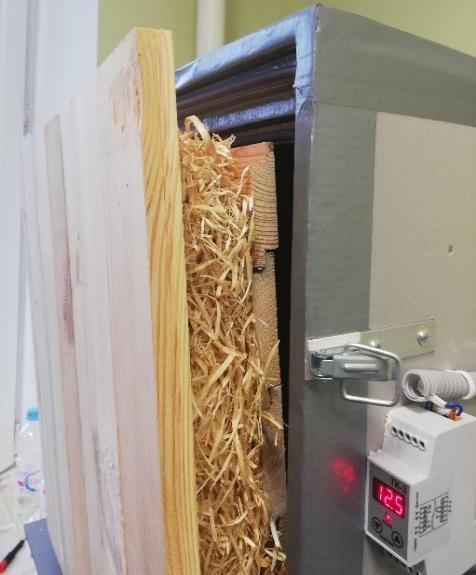
а) b)
Fig. 3 Laboratory climate chamber (a) with installed fragment of the panel (b).
The temperature in the climate chamber was maintained at the level of average winter temperature for Ukraine -17 °С, the room temperature fluctuated at the level of 19 ± 1 °С.
RESULTS AND DISCUSSION
The samples of wood treated with various binders were placed in containers with a substrate. The substrate was a sifted surface layer of soil with a moisture of 40-45%, and acidity in the range of pH 4.5-6.0. The containers were represented by wooden pine boxes with lids (Figure 4). The dimensions of the inner walls of the containers were 450×450×100 mm. The interior of the containers was divided in half by a glass partition for laying treated samples that mimicked insulation boards and untreated samples of low-grade pine wood. The samples were placed in the substrate so that the open part was not more than one third of their length above the surface.
The samples remained in the soil for 60 days. During this period, the moisture of the substrate was monitored by weighing every 15 days. At the end of the experiment, the samples were removed, cleaned from the substrate with a brush, and dried to constant weight, then weighed and percentage of weight loss was determined, Table 1.
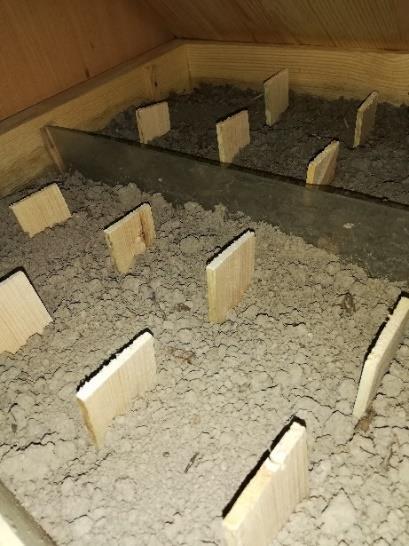
Fig. 4 Container with placed wood samples.
Tab. 1 Weight loss of samples of treated and untreated wood.
Type of samples The average value of weight loss (%)
Raw wood without signs of biological damage Rot-affected wood treated with inorganic binders
2.85 0.97 Rot-affected wood treated with organo-mineral binders 0.62 Standard deviation (%)
2.98 2.48 3.02
It can be seen that wood treated with binders has a fairly high rate of biological stability. The rate of biological destruction was reduced with treating the wood surface with binders. The surface structure of wood was impregnated, capable of resisting the action of biological factors. The binder contains substances with antiseptic properties and can be characterized by resistance to biological factors. The wood treated with inorganic binders shows almost 3 times higher resistance than untreated wood, and wood treated with organomineral binders was on average 4.5 times more resistant as compared to untreated wood. The accuracy of the experimental studies did not exceed 5%. Thus, based on the obtained data, it is possible to make a conclusion about the antiseptic effect of binders on the rotaffected wood and the possibility of protecting this kind ofwood with mentioned substances.
A fragment of a wall construction was chosen for the thermal calculation, namely a wooden frame panel with an area of ��P =12 m2 with thermal insulation based on boards made of wood wool with lining of lumber on both sides. The frame of the panel also consists of wooden vertical bars-racks, horizontal bar elements with a total area of ��b =1.5 m2 , which are areas of heat-conducting inclusions. The calculation of the thermal resistance of the panel with insulation treated with different binders, ��Σ, and wooden bars-racks, ��b, was performed according to equation (6). The effective thermal resistance of the panel ������ according to the standard (DSTU BV.2.6-189: 2013) was calculated by the formula:
��b����+��Σ(���� (8)
The results of the calculations are shown in Table 2.
Tab. 2 Thermal resistance of the panel depending on the thickness of insulation material.
Panel thickness (mm) Insulation thickness (mm) Thermal resistance of an insulating layer with a covering (m2·K/W) Thermal resistance of bars (m2·K/W) Effective thermal resistance of the panel (m2·K/W)
250 210 3.13/2.70 2.20/2.09 3.00/2.62
280 240 3.52/3.00
2.44/2.33 3.37/2.90 310 270 3.90/3.37 2.69/2.58 3.73/3.25 Numerator shows the values for materials treated with organo-mineral binders, denominator – with inorganic binders.
It is clear that the organo-mineral binder in terms of thermal resistance has an advantage over inorganic binder. Therefore, only the samples treated with organo-mineral binder were selected for experimental studies of a wall structure.
In the installed experimental samples of panels with different thickness of insulation instead of the door of the climate chamber, the temperature of theouter surface was measured (Figure 5) with the use of the FLIRi3 thermal imager.
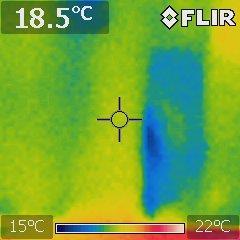
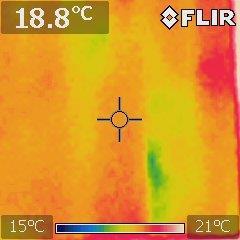
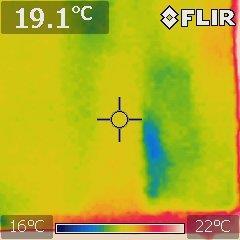
а b c
Fig. 5 Results of measuring the temperature of a wood panel with the thickness of wood wool insulation: a) 210 mm; b) 240 mm; c) 270 mm.
It can be seen that the panel surface had a plus temperature, despite the relatively low minus temperature in the climate chamber. This proves low thermal conductivity of the insulation, which will provide the required level of thermal insulation of a building.
Fluctuations in ambient temperature caused harmonious changes in the temperature in the enclosing structure, which, in turn, causes fluctuations of indoor air temperature. Increasing thermal conductivity of the enclosing structure led to faster transferof the external temperature wave into a room. Accordingly, it is necessary to answer the question of determining thickness of a multilayer panel, which will not be significantly affected by temperature fluctuations. Based on the formula (4), the thickness of a panel at which the oscillations will attenuate “ e ” times can be determined:
1
��√2������ (9)
Taking into account previous experimentally obtained thermo-physical characteristics of the multilayer panel – coefficients of thermal conductivity, density and specific caloric capacity (TSAPKO et al. 2019b), the calculated effective coefficient of thermal conductivity in equation (2) is ������ = 0.87.10-7 m2/s. Accordingly, the thickness of a panel, where the
temperature fluctuations decreased 2.72 times is 2.5 cm, which did not exceed the total thickness of the enclosing structure. The temperature of indoor air remained constant due to the thermal inertia of the main wall structures. As the wall thickness decreased, a significant increase in the amplitude of indoor air temperature fluctuations was observed, while the delay of harmonic outdoor air temperature fluctuations remained constant.
Based on the results obtained and taking into account previous research (TSAPKO et al. 2019a) to ensure comfortable and safe stay in a wooden house, there is possible to use insulation based on wood wool treated with organo-mineral binder. At the same time, wall thickness of 280 mm meets the requirements of state building regulations (DBN B.2.6-31: 2016) for thermal resistance and contributes to attenuation of atmospheric temperature fluctuations.
CONCLUSION
The use of rot-affected pine wood was proposed to manufacture insulation in the form of wood wool treated with organo-mineral binders, which have protective antiseptic properties that do not allow further destruction. Modified wood wool can be used as an internal part of insulating wood panels. The calculation of thermo-physical properties of the wood wool panel from pine wood proves the possibility of its use in wooden frame houses, which contributes to effective and rational use of low-grade pine wood.
REFERENCES
AGARWAL,T.,MALHOTRA,A.,BIYANI,M.,TRIVEDI,P.C. 2011. In vitro interaction of Trichoderma isolates against Aspergillus niger, Chaetomium sp. and Penicilium sp. In Indian Journal of Fundamental and Applied Life Sciences 1(3): 125–128. BABASHOV, V.G., BESPALOV, A.S., ISTOMIN, A.V., VARRIK, N.M. 2017. Heat and sound insulation material prepared using plant raw material. In Refractories and Industrial Ceramics 58(2): 208–213. BOUSLIMI, B., KOUBAA, A., BERGERON, Y. 2014. Effect of biodegradation by brown-rot decay on selected wood properties in eastern white cedar (Thuja occidentalis L.). In International Biodeterioration & Biodegradation 87: 87–98. DANILOV, V., AYZENSHTADT, A., MAKHOVA, T. 2018. Obtaining and characterization of woodmineral Composites. 18th International Multidisciplinary Scientific GeoНе, SGEM Sofia. Vol. 18. p. 347–354. DBN B.2.6-31: 2016. Thermal insulation of buildings. Ministry of Construction of Ukraine. 38 p. (State building standards of Ukraine).
DE MEO,I.,AGNELLI,A.E.,GRAZIANI,A.,KITIKIDOU,K.,LAGOMARSINO,A.,MILIOS,E.,KALLIOPI RADOGLOU, K., PALETTO, A. 2017. Deadwood volume assessment in Calabrian pine (Pinus brutia Ten.) peri-urban forests: Comparison between two sampling methods. In Journal of Sustainable Forestry 36(7): 666–686. DSTU BV.2.6-189: 2013. Methods of selection of heat-insulating material for insulation of buildings. Ministry of Construction of Ukraine. 71 p. ERIKSSON, K.E.L., BLANCHETTE, R.A., ANDER, P. 1990. Microbial and enzymatic degradation of wood and wood components. Springer Verlag, Berlin/Heidelberg, Germany, 80 p. GOST 28206-89. 2006. Basic test methods for external factors. Part 2. Tests. Fungal resistance. M.: Standartinform, 20 p. GOST 18610-82. Wood. Method field tests of resistance to decay M.: Standartinform, 8 p. LEONOVICH, O.K., Bozhelko, I.K. 2019. Development concept of environmentally friendly wooden housing construction in the Republic of Belarus. In Architecture and Construction sciences. No. 1, 2 (22, 23): 60–64.
MANTAU, U. 2012. Wood flows in Europe (EU27). Project report. Celle, 24. MARCHENKO, N.V., NOVITSKIY, S.V., ZAVIALOV, D.L. 2016. On the use of low-quality pine wood. In Annals of Warsaw University of Life Sciences 95: 242–245. MAURER,V.M.,PINCHUK,A.P. 2019. Degradation of Ukraine's forests: current state, causes of mass dehydration and ways to prevent it. In Ukrainian Journal of Forest and Wood Science, 10(3): 41–52.
PERSIANI, A., LOMBARDI, F., LUNGHINI, D., GRANITO, V., TOGNETTI, R., MAGGI, O., PIOLI, S., MARCHETTI, M. 2016. Stand structure and deadwood amount influences saproxylic fungal biodiversity in Mediterranean mountain unmanaged forests. In iForest-Biogeosciences and Forestry 9(1): 115–124. PINCHEVSKA, O.O, ZAVIALOV, D.L. 2020a. Body insulation panels made of low quality pine wood. Abstracts of the participants of the X. International Scientific and Practical Conference "Comprehensive quality assurance of technological processes and systems". Chernihiv: ChNTU. p. 192. PINCHEVSKA,O.O,ZAVIALOV,D.L. 2020b. Determination of the density of a new thermal insulation material. Abstracts of the international scientific-practical conference "Research of forest and urban ecosystems for sustainable development". p. 117–118. SANAEV, V.G., ZAPRUDNOV, V.I., GORBAHEVA, G.A., OBLIVIN, A.N. 2016. Factors affecting the quality of wood-cement composites. In Bulletin of the Transilvania University of Braşov Series II: Forestry. Wood Industry. Agricultural Food Enging, v. 9 (58), No. 2: 63–71. SHVETS, M., MARKOV, F., FITISOV, A., DIDENKO, P. 2020. Analysis of financial and economic activity of state forest enterprises in the conditions of economic and ecological crisis. In Scientific Horizons (6): 92–100.
TSAPKO,Y.V.,ZAVIALOV,D.L.,BONDARENKO,O.P,PINCHEVSKA,O.O,MARCHENKO,N.V.GUZIY, S.G. 2019a.Design of fire-resistant heat-and soundproofing wood wool panels. In Eastern-European Journal of Enterprise Technologies 3(10(99): 24–31.
TSAPKO, Y.V., ZAVIALOV, D.L., BONDARENKO, O.P., MARCHENKO, N.V., MAZURCHUK, S.M., GORBACHOVA, O.Y. 2019b. Establishment of thermophysical characteristics of heat-insulating products from dry pine wood. In Eastern-European Journal of Enterprise Technologies 4(10(100): 37–43. UGOLEV, B.N. 2007. Wood science and forestry commodity science. Moscow State Forest University, Moscow, Russia, pp. 351. WITOMSKI, P, ZAWADZKI, J, RADOMSKI, A. 2012. Changes of the pine wood (Pinus sylvestris L.) chemical composition during white- and brown-rot decay originated from chosen fungi species. In Wood Research 57(3): 463–468.
ACKNOWLEDGEMENTS
This work was supported by the Ukrainian Ministry of Education and Science under Program No. 2201040: “The research, scientific and technological development, works for the state target programs for public order, training of scientific personnel, financial support scientific infrastructure, scientific press, scientific objects, which are national treasures, support of the State Fund for Fundamental Research”. The authors are grateful to Ministry of Education and Science of Ukrainian for financial support of this study. The authors are grateful for financial support to the Slovak Research and Development Agency, projects No. APVV-17-0583, APVV-18-0378, APVV-19-0269 and project VEGA 1/0264/22. This publication is also the result of the project implementation: Progressive research of performance properties of wood-based materials and products (LignoPro), ITMS: 313011T720 (10%) supported by the Operational Programme Integrated Infrastructure (OPII) funded by the ERDF.
AUTHOR’S ADDRESS
Prof. Ing. Olena Pinchevska, DrSc. Denys Zavialov, PhD. Assoc. Prof. Yuri Lakyda, PhD.
Assoc. Prof. Olha Baranova, PhD. Assoc. Prof. Hanna Lobchenko, PhD. National University of Life and Environmental Sciences of Ukraine Department of Technology and Design of Wood Products Geroiv Oborony str. 15 03041 Kyiv Ukraine olenapinchevska@nubip.udu.ua
Prof. Ing. Ján Sedliačik, PhD. Technical University in Zvolen Department of Furniture and Wood Products T. G. Masaryka 24 960 01 Zvolen Slovakia sedliacik@tuzvo.sk
Assoc. Prof. Rostislav Oliynyk, PhD. Kyiv National Taras Shevchenko University Geography Faculty Meteorology and Climatology Department Akademika Glushkova 2a 02000 Kyiv Ukraine rv_oliynyk@ukr.net









